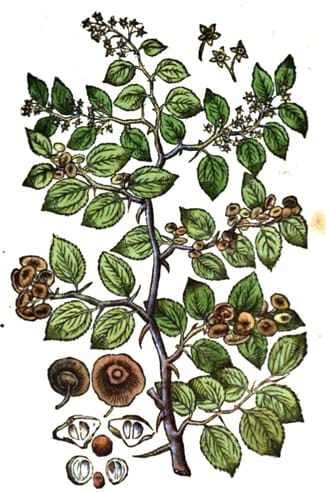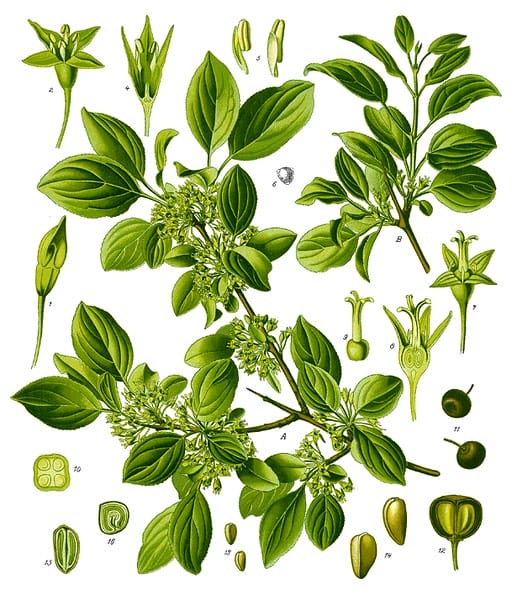Rhamnus, BuckthornPurging Buckthorn |

|
 Kreutterbuch, Matthiolus, 1586
Kreutterbuch, Matthiolus, 1586 Koehler’s Medizinal Pflanzen, 1887
Koehler’s Medizinal Pflanzen, 1887Botanical name:
Rhamnus cathartica
Parts used:
Berries, fresh or dried; less commonly the Bark
Temperature & Taste:
Cold, dry: Bitter, Sour
Uses:
1. Clears Heat, Promotes Stool:
-chronic constipation, hemorrhoids, and irritation of the bowels and anus.
-approved by Commission E for chronic constipation
-suitable for constipation associated with anal fistula or hemorrhoids
-bark decoction is also used for Gastritis from hyper-acidity. (Fruit or bark)
-Gout, Cachexia (Fruit, Haller)
2. Externally:
-as a compress for cuts and wounds
Dose:
Various authors stated the syrup of the berries or of the berry juice was the best preparation, usually with a little Cinnamon or Ginger added.
Dried Fruit: 3–5 grams (or 10–20 fruit); 20 fresh berries have been eaten as a dose
Juice: 1 oz. of the expressed juice
Syrup of the Fruit: half–1 teaspoonful for children; 1–4 tablespoonfuls for adults
Rob (concentrated juice): half oz. of the rob (concentrated juice boiled until thick).
Correctives:
1. Ginger
2. Cinnamon
3. Mastic
4. Licorice

Main Combinations:
1. As a purgative:
i. Buckthorn with Ginger (Syrup of Buckthorn)
ii. Syrup of Buckthorn (1 oz.), Decoction of Prunes (4 oz.)
ii. Buckthorn with Anise, Mastic, Ginger, Cinnamon, Clove (Pharmacopoeia Generalis, 1783)
2. Obesity, Buckthorn with Kelp, Elder flower, Blessed Thistle, Lovage
Cautions:
1. Overdose will cause nausea, diarrhea and vomiting.
2. Not used during pregnancy
3. Not used in acute intestinal inflammation, appendicitis or acute abdominal pain
4. Not used on a long-term basis
Main Preparations used:
Syrup of the concentrated juice made with sugar; Rob
1. Syrup of Buckthorn:
i. clarified Juice of ripe Buckthorn berries (2 parts), Refined Sugar (1 part). Boil to a syrup.
|
‘The Buckthorn was well known to the Anglo-Saxons, and is mentioned as Hartsthorn or Waythorn in their medical writings and glossaries dating before the Norman conquest. The Welsh physicians of Myddfai (“Meddygon Myddvai“) in the 13th century prescribed the juice of the fruit of buckthorn boiled with honey as an aperient drink. As Spina Cervina the shrub is referred to by Piero |
de’ Crescenzi of Bologna about A.D. 1305. The medicinal use of the berries was familiar to all the writers on botany and materia medica of the 16th century. Syrup of buckthorn first appeared in the London Pharmacopoeia of 1650; it was aromatized by means of aniseed, cinnamon, mastic and nutmeg.’ (Pharmacographia, Fluckiger & Hanbury, 1879) |
–Traditional Medicinal Uses, Phytochemicals, and Pharmacological Activities of Genus Rhamnus: A review
ANTIBACTERIAL
–Evaluation of antimicrobial activity of some compounds isolated from Rhamnus cathartica L
–Antibacterial Activities of Gel Containing 5% Hydroalcoholic Extract of Rhamnus cathartica L. bark
–Anthraquinones as potential antimicrobial agents-A review
